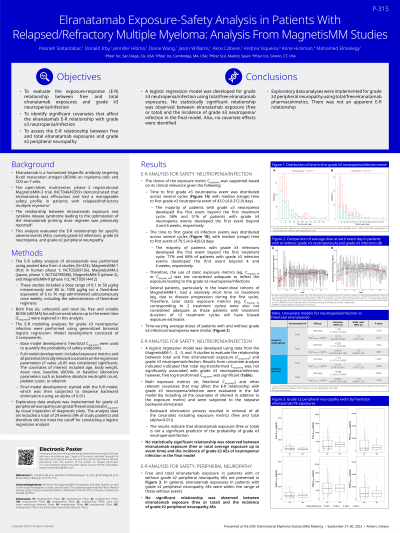Treatment of Relapsed/Refractory Myeloma
Poster Session 2
P-315: Elranatamab exposure-safety analysis in patients with relapsed/refractory multiple myeloma: Analysis from MagnetisMM studies
Thursday, September 28, 2023
12:30 PM - 1:30 PM EEST

- PS
Pooneh Soltantabar, PhD
Clinical Pharmacology Scientist
Pfizer Inc, United States
Introduction: Elranatamab was demonstrated to be an effective treatment for patients (pts) with RRMM with a manageable safety profile based on the results from the Phase 2 (Ph2) MagnetisMM-3 trial (NCT04649359). This analysis explored the exposure-response (ER) for infections, neutropenia and peripheral neuropathy.
Methods: The ER-safety analysis of elranatamab was performed using pooled data from 4 studies: MagnetisMM-1 (first-in-human Ph1, NCT03269136), MagnetisMM-2 (Japan Ph1, NCT04798586), MagnetisMM-3 (Ph2), and MagnetisMM-9 (Ph1/2, NCT05014412). These studies included a dose range of 0.1 to 50 μg/kg IV and 80 to 1000 μg/kg (6 to 76 mg) QW SC. Binomial logistic regression was used. The safety endpoints were Grade ≥ 3 (G3+) neutropenia, G3+ infections and Grade ≥ 2 (G2+) peripheral neuropathy. Base models explored free (ie, unbound) and total (ie, free and sBCMA-bound) elranatamab PK on the probability of developing each of the selected safety endpoints. Average exposure up to the event (Cave,event) was used as the PK metric in this analysis. A Full model was developed for each safety endpoint to explore the influence of clinical and laboratory covariates and PK. Stepwise backward elimination (α =0.01) was used for covariate selection and final model development.
Results: Out of 324 participants treated with elranatamab monotherapy, 47%, 35% and 9% experienced G3+ neutropenia, G3+ infection and G2+ peripheral neuropathy. The median (range) time to first event of G3+ neutropenia and G3+ infection was 43.00 (4 - 312) and 79.5 (4 - 428) days, respectively. Given the distribution of the time to first instance of these events, C_ave,event was used as the exposure metric. For neutropenia, base model results indicated that total C_ave,event was not significantly associated (P-value=0.4307) with G3+ neutropenia, however, free C_ave,event was significant (P-value=0.0272). For infections, total C_ave,event was not significantly associated with G3+ infections (P-value=0.1918) , however, free C_ave,event was significant (P-value=0.0362). Neither the exposure metrics nor the clinical or laboratory covariates were retained in the final models after backward elimination. For peripheral neuropathy, the analysis dataset included a total of 29 events of G2+ peripheral neuropathy which did not allow for a statistical analysis. However, there was no apparent ER relationship by visual inspection of diagnostic plots and exposure in participants with G2+ peripheral neuropathy was within the range of those without events.
Conclusions: No statistically significant relationship was observed between elranatamab exposure (free or total Cave,event) and the incidence of G3+ AEs of neutropenia/infection and G2+ peripheral neuropathy. Elranatamab demonstrated a relatively flat exposure-safety profile. This finding together with the meaningful clinical benefit observed in the MagnetisMM-3 study indicates a favorable benefit-risk for elranatamab at the 76 mg QW/Q2W regimen.
Methods: The ER-safety analysis of elranatamab was performed using pooled data from 4 studies: MagnetisMM-1 (first-in-human Ph1, NCT03269136), MagnetisMM-2 (Japan Ph1, NCT04798586), MagnetisMM-3 (Ph2), and MagnetisMM-9 (Ph1/2, NCT05014412). These studies included a dose range of 0.1 to 50 μg/kg IV and 80 to 1000 μg/kg (6 to 76 mg) QW SC. Binomial logistic regression was used. The safety endpoints were Grade ≥ 3 (G3+) neutropenia, G3+ infections and Grade ≥ 2 (G2+) peripheral neuropathy. Base models explored free (ie, unbound) and total (ie, free and sBCMA-bound) elranatamab PK on the probability of developing each of the selected safety endpoints. Average exposure up to the event (Cave,event) was used as the PK metric in this analysis. A Full model was developed for each safety endpoint to explore the influence of clinical and laboratory covariates and PK. Stepwise backward elimination (α =0.01) was used for covariate selection and final model development.
Results: Out of 324 participants treated with elranatamab monotherapy, 47%, 35% and 9% experienced G3+ neutropenia, G3+ infection and G2+ peripheral neuropathy. The median (range) time to first event of G3+ neutropenia and G3+ infection was 43.00 (4 - 312) and 79.5 (4 - 428) days, respectively. Given the distribution of the time to first instance of these events, C_ave,event was used as the exposure metric. For neutropenia, base model results indicated that total C_ave,event was not significantly associated (P-value=0.4307) with G3+ neutropenia, however, free C_ave,event was significant (P-value=0.0272). For infections, total C_ave,event was not significantly associated with G3+ infections (P-value=0.1918) , however, free C_ave,event was significant (P-value=0.0362). Neither the exposure metrics nor the clinical or laboratory covariates were retained in the final models after backward elimination. For peripheral neuropathy, the analysis dataset included a total of 29 events of G2+ peripheral neuropathy which did not allow for a statistical analysis. However, there was no apparent ER relationship by visual inspection of diagnostic plots and exposure in participants with G2+ peripheral neuropathy was within the range of those without events.
Conclusions: No statistically significant relationship was observed between elranatamab exposure (free or total Cave,event) and the incidence of G3+ AEs of neutropenia/infection and G2+ peripheral neuropathy. Elranatamab demonstrated a relatively flat exposure-safety profile. This finding together with the meaningful clinical benefit observed in the MagnetisMM-3 study indicates a favorable benefit-risk for elranatamab at the 76 mg QW/Q2W regimen.
